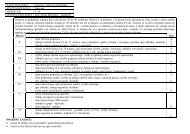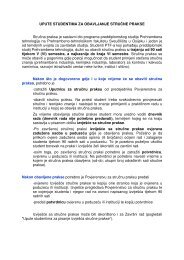ENGLISH IN FOOD TECHNOLOGY I
ENGLISH IN FOOD TECHNOLOGY I
ENGLISH IN FOOD TECHNOLOGY I
Create successful ePaper yourself
Turn your PDF publications into a flip-book with our unique Google optimized e-Paper software.
UNIT 12<br />
BREADMAK<strong>IN</strong>G<br />
Activity 1<br />
Skim the first sentence of each paragraph to get the main ideas of the text.<br />
Figure 8 Bread making<br />
www.homebakingco.com/brsteps.gif (2010-04-08)<br />
The process for producing a certain bread type depends primarily on the required<br />
characteristics of the product. The country and the size of the business also play a role. In<br />
craft bakeries, rather complex methods of making and processing dough are in use, whereas<br />
the processes used in industrial bakeries are, in general, more straightforward. However, in<br />
both types of business, one can distinguish four processing steps in the total breadmaking<br />
process and they have the same specific aims.<br />
Mixing. The aim of the mixing process is more than to obtain a homogeneous mass;<br />
after the homogeneous mass is obtained, the mixing is continued until the dough becomes<br />
extensible. This part of the mixing process is called “gluten development”. In fact, mixing<br />
bread dough up to the necessary stage of development is so difficult that, in former days, the<br />
mixing was done in more than one step. This method is called “sponge and dough”. Part of<br />
the ingredients are mixed into a sponge, and the sponge is given a rest for some time before<br />
the rest of the ingredients are mixed in. With the better mixing equipment presently used in<br />
the bakery, straight-dough methods have become more convenient.<br />
Most bread dough is still made in batch mixers, although continuous mixers, which<br />
produce a continuous flow of dough, have been on the market for more than 5o years. Their<br />
use is not common in the production of daily bread; in the industrial production of other<br />
products, like croissants and pizzas, the use of continuous mixers is somewhat higher.<br />
40

















